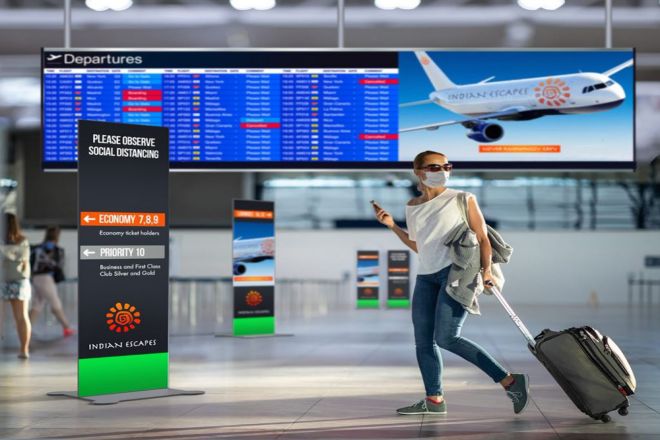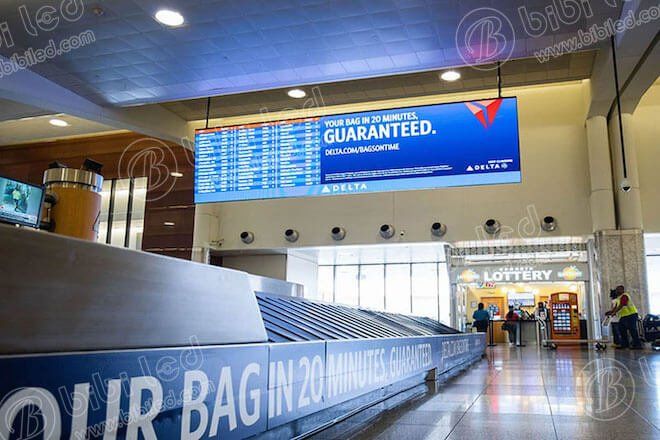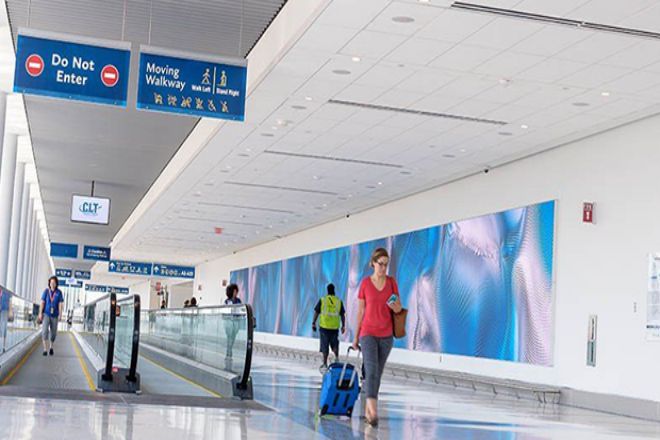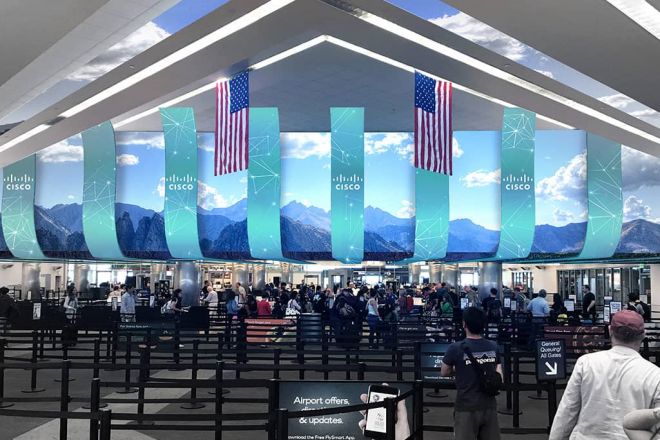Introduction

Can you see various LED displays at the airport? So, if you are the owner of an LED display, how should you use the LED display?
Using LED displays at airports can bring many benefits to passengers, but as the owner of an LED display, I also find it worth paying attention to whether it can bring you benefits.
In the current increasingly fierce market competition environment, how to increase the revenue generated by airport LED displays has become an important issue facing relevant companies and institutions.
1. What is the best advertising strategy for airport LED displays?

The best advertising strategy for airport LED displays is a complex and delicate process, which involves an in-depth understanding of the target audience, clever conception of advertising content, accurate timing of placement, utilization of advanced technology, and data-driven decision-making.
The following are detailed expanded advertising strategy recommendations:
- In-depth analysis of the target audience
Before developing an advertising strategy, you need to conduct a detailed profile of airport travelers. By collecting and analyzing passengers’ travel data, consumption habits, hobbies, and other information, we can draw their user portraits.
For example, business travelers may focus more on high-end brands and services, while family travelers may prefer travel and leisure products. With this in-depth understanding, you can tailor more targeted advertising content to different categories of travelers.
- Creative and content planning
Creativity and planning of advertising content are key to attracting travelers’ attention. It would help if you designed ads that are both visually impactful and convey a clear message.
High-definition picture quality and dynamic effects are the natural advantages of airport LED displays. You can use these features to show the uniqueness of your products or services. At the same time, the advertising content should be concise and clear so as to attract and retain the attention of tourists in a short period of time.
- Delivery timing and frequency
The choice of delivery timing and frequency is crucial to advertising effectiveness. You need to reasonably arrange the playback time of the advertisement based on factors such as the airport’s passenger flow and flight departure and landing times.
For example, during peak hours, such as before passengers board the plane and while waiting for transfers, the frequency of advertisements can be increased to increase exposure. In addition, you can also launch corresponding theme ads in conjunction with special holidays or events to increase the appeal and attention of the ads.
- Data-driven optimization
Data is an important basis for evaluating advertising effectiveness. You need to regularly collect and analyze advertising exposure, click-through rate, conversion rate, and other data to understand the actual effect of advertising.
Based on the results of data analysis, you can adjust your advertising strategy in a timely manner and optimize advertising content, delivery time, and location. Through data-driven optimization, we can continuously improve the performance and return of advertising.
- Cooperation and brand linkage
The advertising strategy of the airport LED display can also cooperate and link with other commercial facilities or brands.
For example, cooperate with catering and retail stores in the airport to jointly launch promotional activities or co-branded products; cooperate with airlines to showcase their route advantages and special services in advertisements; and cooperate with tourism agencies to promote local tourist attractions and cultural characteristics.
Through cooperation and linkage, we can expand the coverage and influence of advertising and achieve resource sharing and mutual benefit.
- Compliance with laws and ethical standards
When developing and executing advertising strategies, we must always comply with relevant laws, regulations, and ethical principles. The advertising content must be legal and compliant and must not contain false, exaggerated, or misleading information.
At the same time, we also need to respect the privacy and rights of passengers and not infringe on their personal information and interests. Only by complying with laws and ethical standards can you win the trust and support of passengers and establish a good brand image.
2. How to optimize airport LED displays for maximum revenue generation

Optimizing airport LED displays to achieve maximum revenue generation is a comprehensive task involving content strategy, technical support, location selection, cooperation brand linkage, etc. Here are some key optimization suggestions:
1). Optimization of content strategy:
Precise positioning: Accurately position advertising content based on the characteristics of passengers at the airport. For example, for business travelers, you can display advertisements for high-end brands and business services; for family travelers, you can display advertisements for travel, parent-child activities, etc.
Creativity and interactivity: Design creative and interactive advertising content to attract travelers’ attention and prompt them to interact. This can be achieved through the use of animations, videos, touch screens, etc.
Real-time updates: Update advertising content in real-time based on current events, festivals, or activities to keep ads fresh and timely.
2). Technical support and equipment maintenance:
High Definition and Color: Ensure the LED display has high resolution and excellent color reproduction to provide clear, lifelike visual effects.
Brightness and contrast adjustment: According to the light environment in the airport, the brightness and contrast of the display screen are adjusted in a timely manner to ensure that the image is clearly visible and not too glaring.
Regular maintenance: Clean and inspect the LED display screen regularly to ensure its normal operation and avoid failures.
3). Location selection:
High-traffic areas: Place LED displays in high-traffic areas within the airport, such as boarding gates, baggage claim areas, waiting halls, etc., to increase the exposure of advertising.
Sight height and angle: Ensure that the installation position and angle of the display screen are suitable for passengers to view, and avoid being too high or too low, which may obstruct the view.
4). Data analysis and optimization:
Data collection: Collect and analyze advertising exposure, click-through rate, conversion rate, and other data to understand the actual effect of advertising.
Optimization and adjustment: Based on data analysis results, timely adjustments are made to advertising content, location, playback time, and other strategies to improve advertising effectiveness and revenue-generating capabilities.
5). User experience:
Avoid visual fatigue: Ensure that advertising content is not too crowded or glaring to avoid causing visual fatigue to passengers.
Provide valuable information: In addition to commercial advertisements, you can also provide flight information, weather forecasts, and other valuable content to improve passenger satisfaction and stickiness.
3. What type of content on airport LED displays is most attractive to advertisers?

The types of content that are most attractive to advertisers on airport LED displays usually have the following characteristics:
- High attention and attraction:
Advertising content needs to be able to quickly grab the attention of passengers and generate strong interest in passengers through unique creativity, visually impactful images or animations, and fascinating storylines.
- Match the target audience:
Advertising content needs to match the characteristics, needs, and consumption habits of airport passengers. For example, ads for high-end brands and business services can be displayed for business travelers, while ads for travel and parent-child activities can be displayed for family travelers.
- Data support and performance evaluation:
Advertisers usually focus on the return on investment of advertising, so advertising content that can provide data support, performance evaluation, and optimization suggestions is more attractive. By collecting and analyzing advertising exposure, click-through rate, conversion rate, and other data, advertisers can be provided with a powerful basis for decision-making.
4. Are there any regulations or restrictions on airport LED display advertising?

There are indeed some regulations and restrictions on airport LED display advertising. These regulations mainly ensure the legality, morality, and public safety of advertising content. Here are some common rules and restrictions:
- Content review:
All advertisements played on airport LED displays must undergo a strict review. Advertising content must comply with national laws, regulations, and industry regulations, and must not contain illegal, false, misleading, or harmful information.
At the same time, advertising content must not infringe the intellectual property rights or reputation rights of others.
- Play duration and frequency:
There are usually clear regulations on the play duration and frequency of advertisements.
This is mainly to ensure that advertisements do not interfere excessively with passengers’ travel experience while ensuring that other information can be played normally.
- Location and layout:
The location and layout of airport LED displays also need to comply with relevant regulations.
For example, the display screen cannot be installed in a place that affects passenger passage or safety, and its layout and size also need to be coordinated with the overall airport environment.
- Advertising form and style:
The form and style of advertising also need to be consistent with the overall image and atmosphere of the airport. For example, the design of advertisements should be concise and clear, and the color matching should be harmonious and should not be too glaring or cause visual fatigue.
- Cooperation and Approval:
The release of airport LED display advertising usually requires the approval of the airport management department and the signing of a relevant cooperation agreement with the airport. This ensures the legality and standardization of advertising releases.
It’s important to note that specific regulations and restrictions may vary by region, airport, and specific policies. Therefore, when publishing airport LED display advertisements, advertisers need to understand and comply with local regulations and policies in detail to ensure the legality and effectiveness of the advertisement.
At the same time, communication and cooperation with the airport management department are also important to ensure the smooth release of advertisements.
Conclusion
Through the discussion in this article, we have conducted an in-depth analysis of various strategies and approaches for increasing revenue for airport LED displays.
From optimizing advertising content to expanding revenue sources, increasing the exposure and attention of the display, and strengthening operations and management, every link contains huge business potential.
I believe you have learned some knowledge. If you want to know more about LED displays, please get in touch with us.
